Despite rallying 29% year-to-date and 47% since 2022, gold continues to reach new all-time highs, hitting $2,685 per troy ounce on Thursday.
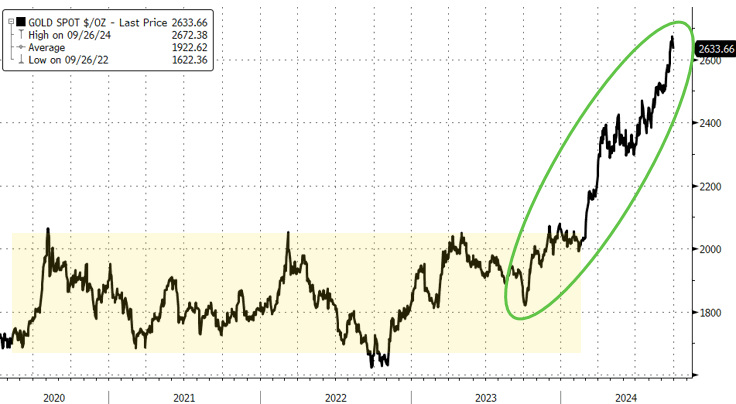
Goldman Sachs’ Precious Metals analysts have revised their gold price forecast, increasing it from $2,700 to $2,900 per ounce for early 2025. This update is based on two main factors:
First, Goldman’s economists anticipate a faster decline in short-term interest rates in both the West and China. They recently highlighted that the gold market hasn’t fully priced in the positive impact of these rate cuts on Western ETF holdings backed by physical gold, which tends to occur gradually.
Second, their updated nowcast shows that emerging market central bank purchases in the London over-the-counter
(OTC) market continue to be a fundamental driver of the gold rally since 2022. Goldman expects these structural purchases to remain elevated.
Under Goldman’s revised forecast, approximately two-thirds of the projected increase in gold prices to $2,900 per ounce by early 2025 is driven by continued central bank purchases on the London OTC market. The remaining one-third is attributed to a gradual rise in ETF flows, spurred by the expected Fed rate cuts.
This forecast also relies on their rule that an additional 100 tonnes of physical demand lifts gold prices by at least 2.4%, which is the lower bound of their regression estimate.
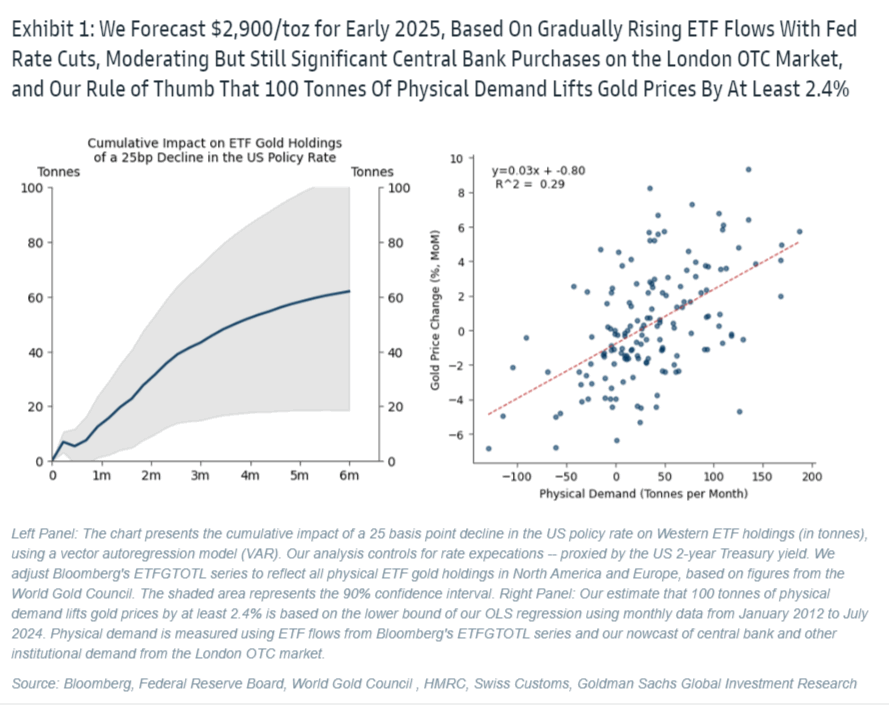
Central Banks Drive the Rally Since 2022
Goldman’s nowcast highlights that emerging market central bank gold purchases in the London OTC market have continued to drive the rally since 2022. Their nowcast for central bank and other institutional demand in the OTC market shows purchases remained strong through July, averaging 730 tonnes annualized year-to-date, or about 15% of global annual production estimates.
A key focus for gold investors is China’s central bank, the People’s Bank of China (PBoC), which has reported a streak of 18 consecutive months of purchases since November 2022. Goldman’s estimates of Chinese institutional gold purchases in the London OTC market generally align with PBoC reports, although Goldman’s estimates are typically higher, start earlier, and last longer.
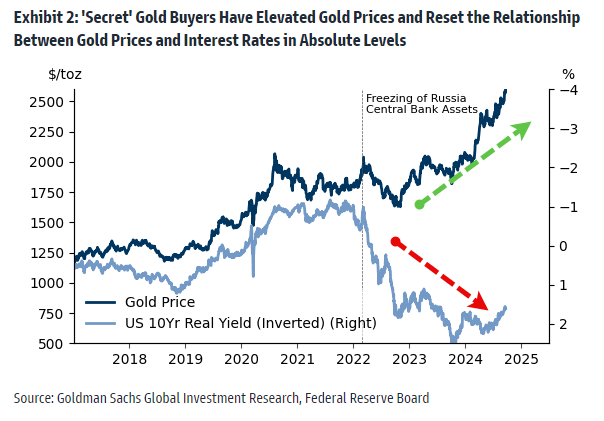
While the PBoC reported no additional purchases after April, Goldman’s nowcast estimates that 50 tonnes of institutional purchases from China took place on the London OTC market in May, with no further activity in June or July.
Goldman’s nowcasting model utilizes customs data and insights into the London OTC market, the largest hub for trading 400 oz gold bars, which are preferred by central banks and other institutions due to their size and lower cost per ounce. London also serves as a storage center for ETF holdings, central bank reserves (held in custody at the Bank of England), and unallocated gold accounts. Changes in gold bar holdings in London vaults serve as a proxy for OTC net demand and align with UK net imports, which are available by trade partners.
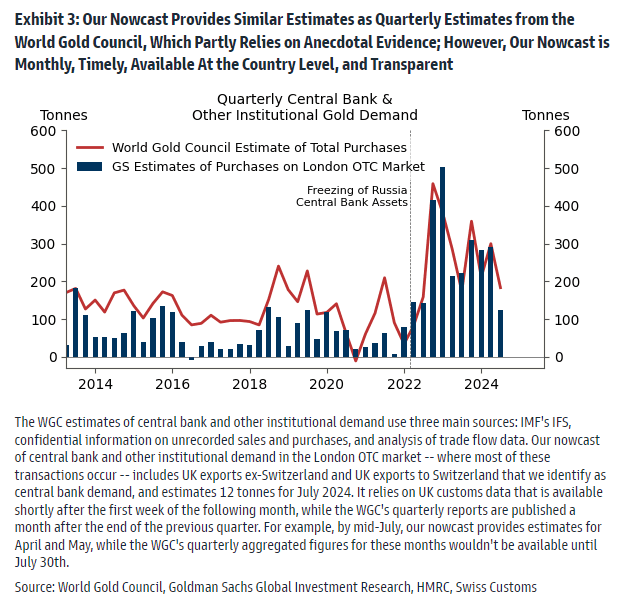
Goldman’s nowcasting model includes two components:
- UK exports of gold bars to countries other than Switzerland.
- The portion of UK exports of gold bars to Switzerland identified as central bank demand.
The distinction between UK gold bar exports to Switzerland and other countries is crucial, as the former usually represents retail demand while the latter reflects central bank and institutional demand. Since the UK does not produce large 400 oz gold bars, it primarily imports them from Switzerland—the global refining hub—when demand in London is high. When demand in London declines, the UK exports these bars back to Switzerland, where they are refined into smaller bars for the retail market.
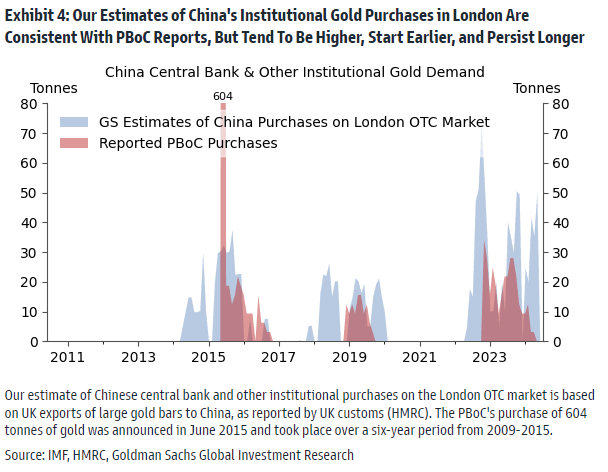
Long on Gold: Key Drivers and Risks
Goldman reiterates their recommendation to go long on gold due to three factors:
- A gradual boost from lower global interest rates.
- Sustained, structurally higher central bank demand.
- Gold’s effectiveness as a hedge against geopolitical risks, financial instability, and recessionary pressures.
Goldman also notes factors that could moderate their base case for significant additional gains in gold prices. These include potential softening in central bank demand (perhaps due to easing geopolitical tensions), lower-than-expected ETF inflows if rate cuts are smaller than anticipated, or a sharper-than-expected decline in China’s retail demand due to price sensitivity or rising consumer confidence.
Professional subscribers can read the full report from Goldman’s Lina Thomas for a deeper understanding of what’s driving Goldman’s increased gold price forecast.
GMR Gold and Our Precious Metals Advisory Services
At GMR Gold, we provide more than just access to precious metals—we offer expert guidance to help you make informed decisions in a dynamic market. Our Precious Metals Advisory Services are designed to support investors in navigating the complexities of the gold market, whether you’re diversifying your portfolio, converting a 401(k) to gold, or exploring new opportunities in precious metals.
Our team of experienced advisors offers personalized insights, leveraging in-depth market analysis and years of expertise to help you achieve your financial goals. With the ongoing economic uncertainty and rising gold prices, there’s no better time to consider adding gold to your investment strategy.
Take advantage of our expertise, and let us guide you toward a secure and prosperous future. Explore our offerings at GMR Gold and learn how our Precious Metals Advisory Services can help you capitalize on the strength of gold.
Contact us today to learn more and start securing your wealth with precious metals.
